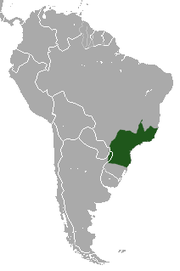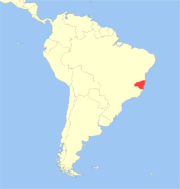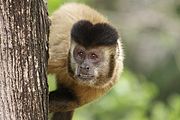| Robust capuchin monkey Temporal range: Late Miocene to present | |
|---|---|

| |
| Four species of robust capuchins, from top to bottom, from left to right: S. flavius, S. xanthosternos, S. nigritus, S. libidinosus | |
| Scientific classification | |
| Domain: | Eukaryota |
| Kingdom: | Animalia |
| Phylum: | Chordata |
| Class: | Mammalia |
| Order: | Primates |
| Suborder: | Haplorhini |
| Infraorder: | Simiiformes |
| Family: | Cebidae |
| Subfamily: | Cebinae |
| Genus: | Sapajus Kerr, 1792 |
| Type species | |
| Simia apella Linnaeus, 1758 | |
| Species | |

| |
| Range of robust capuchin monkeys S. apella S. cay S. flavius S. libidinosus S. macrocephalus S. nigritus S. robustus S. xanthosternos | |
Robust capuchin monkeys are capuchin monkeys in the genus Sapajus. Formerly, all capuchin monkeys were placed in the genus Cebus. Sapajus was erected in 2012 by Jessica Lynch Alfaro et al. to differentiate the robust (tufted) capuchin monkeys (formerly the C. apella group) from the gracile capuchin monkeys (formerly the C. capucinus group), which remain in Cebus.
Taxonomy
Based on the species and subspecies proposed by Groves in 2001 and 2005, robust capuchin monkey taxa include:
| Common name | Scientific name and subspecies | Range | Size and ecology | IUCN status and estimated population |
|---|---|---|---|---|
| Black-capped, brown or tufted capuchin | Sapajus apella (Linnaeus, 1758) Six subspecies
|
South America and the Caribbean islands of Trinidad and Margarita
|
Size: Habitat: Diet: |
LC
|
| Blond capuchin | Sapajus flavius (Schreber, 1774) |
Brazil (northeastern Atlantic Forest extended in the states of Paraíba, Pernambuco, and Alagoas)
|
Size: Habitat: Diet: |
EN
|
| Black-striped capuchin | Sapajus libidinosus (Spix, 1823) Three subspecies
|
northern and central Brazil.
|
Size: Habitat: Diet: |
NT
|
| Azaras's capuchin | Sapajus cay (Illiger, 1815) |
eastern Paraguay, southeastern Bolivia, northern Argentina, and Brazil (Mato Grosso do Sul and Mato Grosso)
|
Size: Habitat: Diet: |
VU
|
| Black capuchin | Sapajus nigritus (Goldfuss, 1809) Two subspecies
|
North-eastern Argentina and South-eastern Brazil
|
Size: Habitat: Diet: |
NT
|
| Crested capuchin or robust tufted capuchin | Sapajus robustus Kuhl, 1820 |
Brazil ( Espírito Santo, Minas Gerais and Bahia)
|
Size: Habitat: Diet: |
EN
|
| Golden-bellied capuchin | Sapajus xanthosternos Wied-Neuwied, 1826 |
south-eastern Bahia, Brazil
|
Size: Habitat: Diet: |
CR
|
S. flavius was only rediscovered in 2006. The specific species and subspecies within Sapajus are not universally agreed upon. For example, Silva (2001) proposed a slightly different species and subspecies split in which, for example Azara's capuchun, Sapajus libidinosus paraguayanus, is considered a separate species, Sapajus cay, as are the large-headed capuchin and the crested capuchin.
Taxonomic history

Philip Hershkovitz and William Charles Osman Hill published taxonomies of the capuchin monkeys in 1949 and 1960, respectively. These taxonomies included all robust capuchins, described then as the tufted group, in the single species Cebus apella, while three gracile (untufted) capuchin species were recognized. Over time, the original C. apella was split into the additional species of robust capuchin monkeys recognized today. In 2001, Silva published a study in which he found greater genetic diversity among robust capuchins than among gracile capuchins. Silva's study also concluded that due to the differences between robust and gracile capuchins, the two groups should at least be placed in separate subgenera within the genus Cebus, offering Sapajus as the subgenus name for robust capuchins. After further studies of the morphology and genetics of the capuchin monkeys, Lynch Alfaro, Silva and Rylands proposed elevating Sapajus to a separate genus in 2012.
Evolutionary history
The genetic studies led by Lynch Alfaro concluded that robust and gracile capuchin monkey genera diverged about 6.2 million years ago. This is approximately the same time that humans and chimpanzees are believed to have diverged. In contrast, capuchins diverged from their nearest common relative, squirrel monkeys, over 13 million years ago. Lynch Alfaro suggested that the formation of the Amazon River may have caused the split that led to separation of robust and gracile capuchins. The robust capuchins then evolved in the Atlantic forest, while the gracile capuchins evolved in the Amazon.
In the late Pleistocene, about 400,000 years ago, robust capuchins began to expand their range northwards into the Cerrado and the Amazon. In some of these areas robust capuchins outcompeted gracile capuchins, and are now the only capuchin monkeys in the area, while particularly in the north Amazon, robust capuchins are sympatric with gracile capuchins. In areas of sympatry, robust capuchins achieve higher population densities than gracile capuchins. This is thought to reflect the advantage of the adaptations for durophagy in the robust forms, which allow them to exploit hard nuts, palm fruit and unripe fruit, while gracile forms are more restricted to ripe fruit. In general, robust capuchins seem to be more flexible in their diet.
Morphology

Robust capuchins differ in morphology from gracile capuchins in a number of respects. Some of these are related to behavioral differences between the two genera. Robust capuchins have shorter limbs relative to body size than gracile capuchins. There are significant differences between the skulls of robust and gracile capuchins, particularly among males. These differences include the shape of the nasal aperture and the shape of the mandible. The canine teeth are also different; robust capuchins' canines are shorter and more robust than those of gracile capuchins. Male robust capuchins also have a sagittal crest, which is lacking in gracile capuchins, and larger, thicker mandibles than gracile capuchins. Some of these differences, such as the sagittal crest, the mandibles and teeth reflect robust capuchins' diet, which includes hard nuts and palm fruits that are difficult for gracile capuchins to consume.
Robust capuchins also have some uniformly consistent features of their fur. All robust capuchins have a tuft of fur on their head, at least to some extent, while no male gracile capuchins have such a tuft. They also all have a beard to some degree, which gracile capuchins lack. All robust capuchins have dark fur along their "sideburns" and above their eyes.
Tool use
Some robust capuchins species are known to use stone tools in the wild. These are used to habitually crack open nuts and other shelled fruits, seeds and even oysters. Male capuchins use tools to crack open nuts more frequently than females and body mass is the best predictor of efficiency, but the sexes do not differ in terms of efficiency. Some populations have also been known to use stone tools for digging soil and stick probing tools to flush out prey or dip liquid. Robust capuchins are also known at times to rub defensive secretions from arthropods over their bodies before eating them; such secretions are believed to act as natural insecticides.
References
- ^ Lynch Alfaro, J. W.; Silva, J. S. & Rylands, A. B. (2012). "How Different Are Robust and Gracile Capuchin Monkeys? An Argument for the Use of Sapajus and Cebus". American Journal of Primatology. 74 (4): 1–14. doi:10.1002/ajp.22007. PMID 22328205. S2CID 18840598.
- ^ Lynch Alfaro, J.W.; et al. (2011). "Explosive Pleistocene range expansion leads to widespread Amazonian sympatry between robust and gracile capuchin monkeys" (PDF). Journal of Biogeography. 39 (2): 272–88. doi:10.1111/j.1365-2699.2011.02609.x. S2CID 13791283. Archived from the original (PDF) on 2015-02-26.
- Groves, C. P. (2005). "Genus Cebus". In Wilson, D. E.; Reeder, D. M (eds.). Mammal Species of the World: A Taxonomic and Geographic Reference (3rd ed.). Johns Hopkins University Press. pp. 136–138. ISBN 978-0-8018-8221-0. OCLC 62265494.
- ^ Rímoli, J.; de Melo, F.R.; dos Santos, M.C.; Mollinedo, J.M.; Ludwig, G.; Lynch Alfaro, J.W. (2021). "Sapajus cay". IUCN Red List of Threatened Species. 2021: e.T136366A192593536. doi:10.2305/IUCN.UK.2021-1.RLTS.T136366A192593536.en. Retrieved 11 November 2021.
- Fragaszy, D.; Izar, P.; Visalberghi, E.; Ottoni, E. B.; de Oliveira, M. G. (2004). "Wild capuchin monkeys (Cebus libidinosus) use anvils and stone pounding tools". American Journal of Primatology. 64 (4): 359–366. doi:10.1002/ajp.20085. PMID 15580579. S2CID 16222308.
- Ottoni, E. B.; Izar, P. (2008). "Capuchin monkey tool use: Overview and implications". Evolutionary Anthropology. 17 (4): 171–178. doi:10.1002/evan.20185. S2CID 83604383.
- Ottoni, E. B.; Mannu, M. (2001). "Semifree-ranging Tufted Capuchins (Cebus apella) Spontaneously Use Tools to Crack Open Nuts" (PDF). International Journal of Primatology. 22 (3): 347–358. doi:10.1023/A:1010747426841. S2CID 29768277.
- ^ Garber, P. A., Gomez, D. F. & Bicca-Marques, J. C. (2011). "Experimental Field Study of Problem-Solving Using Tools in Free-Ranging Capuchins (Sapajus nigritus, formerly Cebus nigritus)". American Journal of Primatology. 74 (4): 344–358. doi:10.1002/ajp.20957. PMID 21538454. S2CID 39363765. Retrieved 2012-03-18.
{{cite journal}}: CS1 maint: multiple names: authors list (link) - ^ Spagnoletti, Noemi; Visalberghi, Elisabetta; Verderane, Michele P.; Ottoni, Eduardo; Izar, Patricia; Fragaszy, Dorothy (May 2012). "Stone tool use in wild bearded capuchin monkeys, Cebus libidinosus. Is it a strategy to overcome food scarcity?". Animal Behaviour. 83 (5): 1285–1294. doi:10.1016/j.anbehav.2012.03.002. S2CID 1046994.
- Mannu, Massimo; Ottoni, Eduardo B. (March 2009). "The enhanced tool-kit of two groups of wild bearded capuchin monkeys in the Caatinga: tool making, associative use, and secondary tools". American Journal of Primatology. 71 (3): 242–251. doi:10.1002/ajp.20642. PMID 19051323. S2CID 3479020.
- Falótico, Tiago; Ottoni, Eduardo B. (2014-10-01). "Sexual bias in probe tool manufacture and use by wild bearded capuchin monkeys". Behavioural Processes. 108: 117–122. doi:10.1016/j.beproc.2014.09.036. PMID 25446625. S2CID 8170698.
- Falótico, Tiago; Ottoni, Eduardo B. (2016-04-21). "The manifold use of pounding stone tools by wild capuchin monkeys of Serra da Capivara National Park, Brazil". Behaviour. 153 (4): 421–442. doi:10.1163/1568539X-00003357. ISSN 1568-539X.
- Falótico, Tiago; Ottoni, Eduardo B. (2013-11-21). "Stone Throwing as a Sexual Display in Wild Female Bearded Capuchin Monkeys, Sapajus libidinosus". PLOS ONE. 8 (11): e79535. Bibcode:2013PLoSO...879535F. doi:10.1371/journal.pone.0079535. ISSN 1932-6203. PMC 3836890. PMID 24278147.
- Alfaro, Jessica W. Lynch; Matthews, Luke; Boyette, Adam H.; Macfarlan, Shane J.; Phillips, Kimberley A.; Falótico, Tiago; Ottoni, Eduardo; Verderane, Michele; Izar, Patrícia (2012-04-01). "Anointing variation across wild capuchin populations: a review of material preferences, bout frequency and anointing sociality in Cebus and Sapajus". American Journal of Primatology. 74 (4): 299–314. doi:10.1002/ajp.20971. ISSN 1098-2345. PMID 21769906. S2CID 14560688.
- Valderrama, X.; et al. (2000). "Seasonal Anointment with Millipedes in a Wild Primate: A Chemical Defense Against Insects?". Journal of Chemical Ecology. 26 (12): 2781–2790. doi:10.1023/A:1026489826714. S2CID 25147071.
- Verderane, M. P.; Falótico, T.; Resende, B. D.; Labruna, M. B.; Izar, P.; Ottoni, E. B. (2007-01-17). "Anting in a Semifree-ranging Group of Cebus apella". International Journal of Primatology. 28 (1): 47. doi:10.1007/s10764-006-9102-8. ISSN 0164-0291. S2CID 39385045.
| Haplorhini | |||||||||||||||||||||||||||||||||||||||||||||
|---|---|---|---|---|---|---|---|---|---|---|---|---|---|---|---|---|---|---|---|---|---|---|---|---|---|---|---|---|---|---|---|---|---|---|---|---|---|---|---|---|---|---|---|---|---|
| |||||||||||||||||||||||||||||||||||||||||||||
| |||||||||||||||||||||||||||||||||||||||||||||
| |||||||||||||||||||||||||||||||||||||||||||||
| |||||||||||||||||||||||||||||||||||||||||||||
| Taxon identifiers | |
|---|---|
| Sapajus | |










